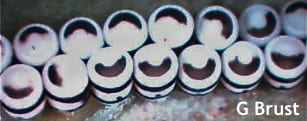Jerry Brust, IPM Vegetable Specialist, University of Maryland; jbrust@umd.edu
This has been a tough growing season for most of our vegetable crops. Some crops were planted late and had problems setting fruit later on in the summer heat while others that were planted on time were 2-3 weeks ahead of harvest schedule. Some crops have done OK and a few have done well, but most others have suffered due to the weather. Late summer/early fall crops are not fairing much better. I have received several reports of mysterious feeding on plantings of tomatoes and carrots, and reports of damage by pests that were easily seen, because there were so many of them. In many of the cases it was probably two common late summer pests: the blister beetle and Harlequin bugs.
Blister Beetles (family Meloidae)
Blister beetles are commonly seen in fields starting in late June going through the fall. There seems to be a great deal of them this year feeding on just about every new and even old vegetable planting. Adult blister beetles vary in color and size. Most are one-half to one inch long with long, soft bodies and wide heads. The area between the head and the body is narrow and looks like a neck. The wing covers are leathery with the abdomen often times extending beyond the end of the wings (Fig. 1). The legs are relatively long for the body size. The beetles come in a variety of dark or bright colors that are variegated, striped or flat. Striped blister beetles are shades of gray and brown with yellow stripes running lengthwise on its wing covers. Others are gray to black with a gray or white margin around each wing (Fig. 1).
Adults begin laying eggs in the spring and continue through most of the season. Females will lay one to two hundred very small eggs just beneath the soil surface. White larvae hatch from these eggs in about two weeks and have relatively long legs which they use to find their main prey–grasshopper eggs (so the larvae are beneficial, while the adults are a pain). Most larvae will go through 4-5 instars but some go through 6-7. Adults emerge from the pupae stage after ten days.
If you look up blister beetles most of the literature deals with the beetles as a threat to horses and livestock. The beetles secrete and contain within them a blistering chemical called catharidin. Catharidin is toxic if ingested and it persists in dead beetles long after the hay they infested was dried and baled. Horses are particularly susceptible to the poisoning. Humans who ingest the beetle can suffer severe damage to the urinary tract and gastrointestinal lining.
Blister beetles will feed on just about any plant: tomato, potato, eggplant, peppers and other solanaceous vegetables as well leafy greens. Often times in late summer, they arrive in swarms, seemingly overnight and can feed heavily on plants and then just as suddenly disappear — often leaving growers perplexed as to what came in and did the feeding damage. A beetle will feed for a time and then usually move on to another spot not causing a great deal of damage unless there are a significant number of them or they stay in one place for an extended period of time. Covering plants with a row cover or with kaolin clay (product called Surround) BEFORE the beetles start to feed has worked pretty well, but the row cover or clay must be applied before they start to feed. If applied after they are found feeding it is not as effective. Pyrethroids also will work well if beetles are directly contacted.
Figure 1. Two adult Margined blister beetles Epicauta funebris
Harlequin Bugs (Murgantia histrionica)
Adult harlequin bugs are red- or orange-and-black-spotted bugs about 3/8 of an inch long, with flat, shield-shaped bodies (Fig. 2). Nymphs are similar in general color and shape to the adults (Fig. 3). The eggs of harlequin bugs are distinctive and look like no other stink bug eggs—or anything else. The eggs look like tiny white barrels standing on end, typically in a double row (Fig. 4). Twelve to eighteen eggs are usually laid together in one batch on the underside of the leaves of the host plant. Each egg is marked by two broad black stripes near the ends of the “barrel” (egg) with one black spot in the middle of the egg and a black mark on top of each egg. Harlequin bugs over winter as adults (rarely large nymphs) in old cabbage stalks or any other crop debris.
Figure 2. Harlequin bug adult
Figure 3. Harlequin bug nymph and damage-white spots
Plants commonly attacked by harlequin bugs include crucifers such as horseradish, cabbage, forage radish, collards, mustard, Brussels sprouts, turnip, kohlrabi and radish. If these are not available hungry bugs will feed on tomato, potato, eggplant, okra, bean, asparagus, beet, weeds, and even fruit trees and field crops. The harlequin bug feeds by injecting salivary secretions into plants that liquefy plant tissue so they can ingest it. This feeding at first results in white spots (Fig. 3) and then progresses to browning, wilting and eventual death of the plant. New plantings of crucifers can be heavily attacked in the spring but more commonly in the fall and this is what I have heard about and seen happening in several areas of Maryland. As with blister beetles, harlequin bugs can be managed by using a row cover or kaolin clay BEFORE they show up and start feeding. Once they start feeding these two controls do not work very well. Pyrethroids will reduce the damage, but there is often a 7-day pre-harvest interval (phi) with many of the chemicals depending on what the crop is. So be sure to check the label to find the correct phi for the product you are using on the particular crucifer you are using it on.
Figure 4. Harlequin bug eggs




